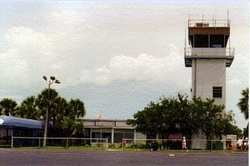Boyer Tells Airport Conference Each Airport Could Lose $150,000
In Entitlements
The Bush Administration's budget proposal for fiscal year 2006
is bad for general aviation airports and could cause each eligible
airport to lose a $150,000 "entitlement" next year. AOPA had worked
hard to put that aid for small airports into law several years ago.
That threat to GA airports was one of the key points in AOPA
President Phil Boyer's keynote speech Tuesday night to the FAA's
Eastern Region Twenty-eighth Annual Airport Conference in Hershey,
Pennsylvania.

Boyer spoke to more than 600 airport managers, consultants, and
government officials, detailing what AOPA has done and is doing to
protect airports such as Albert Whitted Airport and Witham Field in
Florida; Lee's Summit in Missouri; and Rialto, Santa Paula, and
Truckee-Tahoe airports in California.
FAA Regional Administrator Arlene Feldman introduced Boyer,
saying, "Phil Boyer and AOPA are the voice of general
aviation."
"AOPA's top priorities are protecting airports, fighting
temporary flight restrictions and user fees, and reducing the cost
of flying," said Boyer. "And one of the biggest threats to airports
right now is the reduced Airport Improvement Program funding in
President Bush's proposed FAA budget."
Overall, the president cut the FAA's 2006 budget by 1.27
percent. But the administration took a much bigger chunk out of the
Airport Improvement Program (AIP), lopping off some $600 million
from the amount Congress had authorized. If the AIP budget is not
increased from the $3 billion proposed by the administration,
general aviation airports are going to be hurt significantly more
than the air carrier airports because of funding formulas written
into law. If the AIP budget drops below $3.2 billion, the set-aside
for GA airports would be reduced from 20 to 18.5 percent. That
means GA would get an even smaller portion of a smaller pie.
 Even worse for small GA airports,
the general aviation "entitlement" of up to $150,000 per eligible
airport would also be eliminated. For many small airports, that is
the only source of federal funding.
Even worse for small GA airports,
the general aviation "entitlement" of up to $150,000 per eligible
airport would also be eliminated. For many small airports, that is
the only source of federal funding.
"The small airports that can afford it the least will be hurt
the most," Boyer told the conference.
To protect those GA airports, AOPA focuses on three key areas,
Boyer said. First, the association provides advocacy and support
from headquarters. That includes lobbying Congress for laws to
protect airports and adequate funding; media and public relations
efforts, such as the General Aviation Serving America Web site; and
specific campaigns such as community information efforts for
threatened airports.
AOPA also provides support for its regional representatives and
Airport Support Network volunteers, whose hard work at the
community level has frequently been key in saving an airport.
Boyer noted that while AOPA can do a lot to help save airports,
the involvement of local pilots and community support is really the
deciding factor.
The FAA recognized that by presenting its first annual General
Aviation Airport of the Year award to Upshur County Regional (W22)
in Buckhannon, West Virginia. The award was accepted by Airport
Commission President William Wellings, who is also the AOPA Airport
Support Network volunteer for Upshur County.

The airport had been threatened, but "we focused on changing the
outlook of the community and campaigned for community support,"
said Wellings. They showed the benefits of the airport, and the FAA
recognized the turn-around and improvements.
Boyer noted that the 600-plus turnout at the conference is the
largest he's ever seen. "I think this indicates a growing interest
in general aviation," he said.
 ANN's Daily Aero-Linx (04.16.24)
ANN's Daily Aero-Linx (04.16.24) Aero-News: Quote of the Day (04.16.24)
Aero-News: Quote of the Day (04.16.24) Airborne 04.10.24: SnF24!, A50 Heritage Reveal, HeliCycle!, Montaer MC-01
Airborne 04.10.24: SnF24!, A50 Heritage Reveal, HeliCycle!, Montaer MC-01 Airborne 04.12.24: SnF24!, G100UL Is Here, Holy Micro, Plane Tags
Airborne 04.12.24: SnF24!, G100UL Is Here, Holy Micro, Plane Tags Airborne-Flight Training 04.17.24: Feds Need Controllers, Spirit Delay, Redbird
Airborne-Flight Training 04.17.24: Feds Need Controllers, Spirit Delay, Redbird





